p.3
p.8
p.14
p.20
p.27
p.31
p.38
p.47
Alginate Used to Develop Bio-Inspired Composite Microparticles for Bone Regeneration
Abstract:
This work describes the synthesis of composite particles for bone regeneration. The developed method is based on a bio-inspired approach starting from the composition, properties and hierarchical organization of bone extracellular matrix (ECM). The composite material was designed as spherical particles able to ensure interconnected porosity through their assembling inside the bone defect. nanohydroxyapatite was generated in the organic matrix in order to mimic the composition and the organization of the mineral phase in bone tissue. A collagen derivative was used as main natural polymer of the organic matrix of the composite material, in order to mimic the composition of bone ECM. Alginate represents the second organic polymer due to its recognized capacity to easily generate spherical particles in divalent cations solutions. The combination of this polysaccharide with the two previously mentioned components simultaneously responds the architectural and compositional constraints of this approach. The particles were obtained using a modular electrostatic bead generator developed in our laboratory. Briefly, a solution containing the biopolymers was extruded into a mineralisation solution. Spherical particles with diameters of about 500 μm were obtained. They were characterised by scanning electron microscopy, X-ray diffraction, stability in aqueous media. The obtained results confirmed the importance of alginate to generate spherical particles and the potential of such materials to successfully serve the targeted application.
Info:
Periodical:
Pages:
20-26
Citation:
Online since:
March 2015
Keywords:
Price:
Сopyright:
© 2015 Trans Tech Publications Ltd. All Rights Reserved
Share:
Citation:


